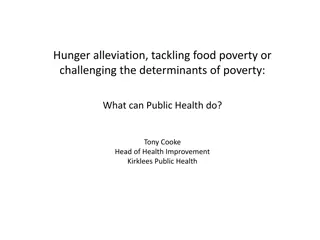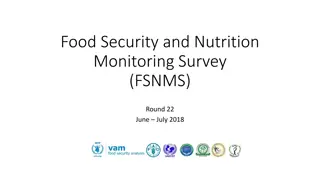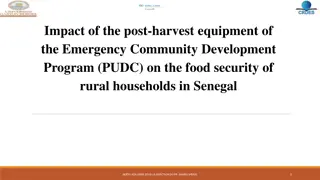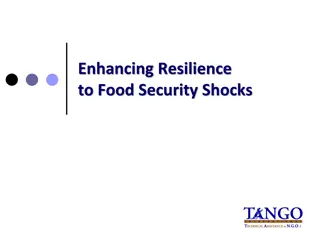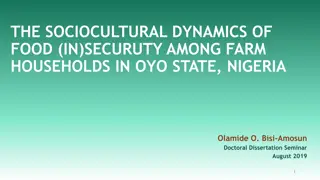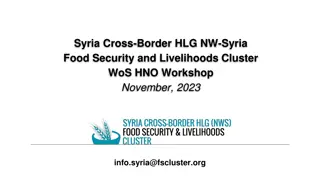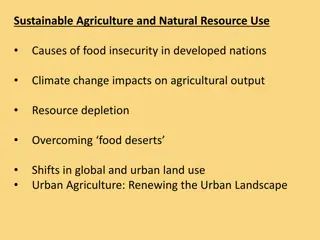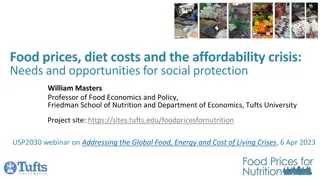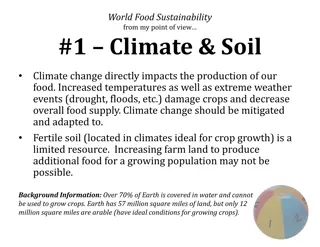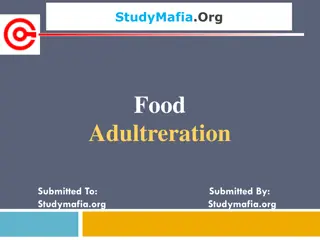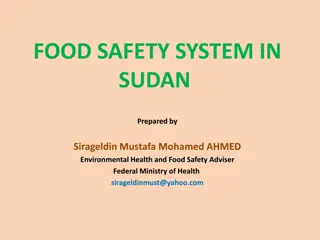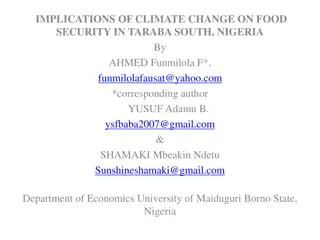Understanding One Health Approach for Food Security and Public Health
The concept of One Health emphasizes the interconnectedness of human, animal, and environmental health. This approach explores how animal-borne illnesses impact food security, public health, and overall well-being. By examining diseases like avian influenza, Newcastle disease, and brucellosis, we see the significant burden they pose to both animals and humans, affecting nutrition, immunity, and disease susceptibility. Utilizing goats and chickens as sources of nutrition highlights the importance of sustainable agricultural practices and the potential implications on human development and economic outcomes.
Uploaded on Sep 15, 2024 | 0 Views
Download Presentation

Please find below an Image/Link to download the presentation.
The content on the website is provided AS IS for your information and personal use only. It may not be sold, licensed, or shared on other websites without obtaining consent from the author. Download presentation by click this link. If you encounter any issues during the download, it is possible that the publisher has removed the file from their server.
E N D
Presentation Transcript
"One Health" Food Security, Public Health and Other Consequences of Animal- borne Illnesses Sharon Jackson
Food Security, Public Health and Other Consequences of Animal-borne Illnesses What is One Health? Why is it important?
Food Security, Public Health and Other Consequences of Animal-borne Illnesses One Health affects Food Security affects Nutritional Status affects Immunity affects Disease Susceptibility
Food Security, Public Health and Other Consequences of Animal-borne Illnesses Key characteristic Human Nutrition Goats and chickens are important sources of nutrition
Food Security, Public Health and Other Consequences of Animal-borne Illnesses
Food Security, Public Health and Other Consequences of Animal-borne Illnesses Advantage of goats and chickens in food security No requirement for formal feed inputs Sustainability of goats and chickens in agricultural production Food Non-food animal products Fertilizer hair
Food Security, Public Health and Other Consequences of Animal-borne Illnesses Animal and human burden of disease Avian influenza May cause significant disease if a highly pathogenic variant in both domestic birds and humans Spread by infectious droppings or aerosols Newcastle disease May cause significant disease in domestic birds , minor disease in humans Spread by infectious aerosols Brucellosis May have significant disease in humans, may be asymptomatic in goats Spread by contact with infectious material, including milk
Food Security, Public Health and Other Consequences of Animal-borne Illnesses Loss of protein provided goats and chickens Adults and child development Less wealth accumulation Loss or reduction in eggs and milk
Food Security, Public Health and Other Consequences of Animal-borne Illnesses The relationship between nutrition and human immune function Protein Micronutrients (vitamins and minerals)
Food Security, Public Health and Other Consequences of Animal-borne Illnesses Malnutrition is estimated to be an underlying cause of death for 55 percent of all deaths in children under 15 years old in the developing world from perinatal causes and infectious diseases. Source: Infectious Disease Epidemiology Kenrad Nelsen et al
Food Security, Public Health and Other Consequences of Animal-borne Illnesses Malnutrition and infectious disease susceptibility and maternal health Impact on pregnancy, parturition and post- parturition Impact of low birth weight Circulation of common childhood and other diseases Circulation of neglected diseases of the developing world
Food Security, Public Health and Other Consequences of Animal-borne Illnesses Diarrheal disease Vitamins A, D, B12, folate, copper, iron, manganese, selenium, zinc Lower respiratory infections Vitamin D, calcium, zinc Measles Vitamin A TB Vitamin A, D (malnutrition is a major risk factor for progression) Malaria Vitamin A, zinc
Food Security, Public Health and Other Consequences of Animal-borne Illnesses Health, nutrition, and economic costs and productivity Ability to perform work Costs of medical care Ability to contribute to the non-farm economy Ability to provide for family members DALY and QALY
Food Security, Public Health and Other Consequences of Animal-borne Illnesses Other health effects Chronic disease infectious agents likely determine more cancers, immune mediated syndromes, neurodevelopmental disorders and other chronic conditions than currently appreciated. Emerging Infectious Diseases www.cdc.gov/eid Vol. 12, No. 7, July 2006 O Connor, Taylor, and Hughes
Food Security, Public Health and Other Consequences of Animal-borne Illnesses Questions?



